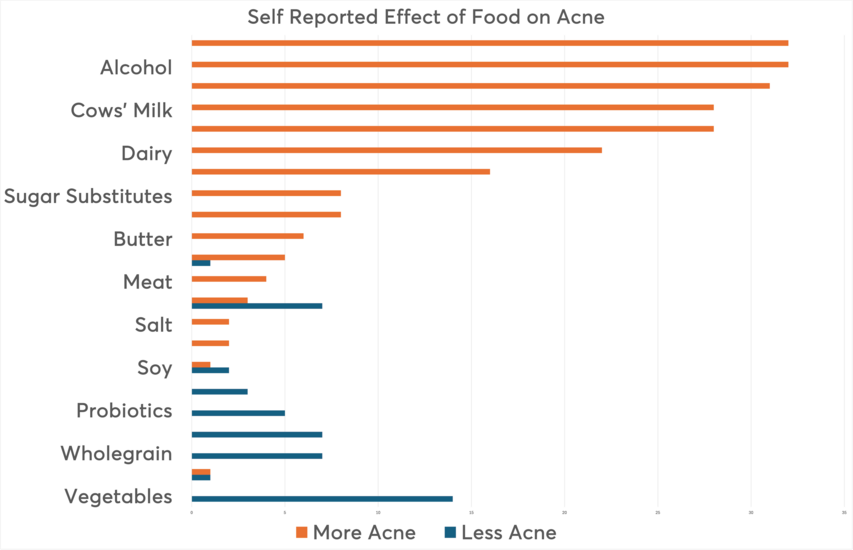The best diet for people with acne

Which food do you need to avoid when you have cystic acne?
1. Dairy products
Milk, cheese, and other dairy products can raise insulin levels, leading to the overproduction of androgen hormones that play a role in acne. Be particularly careful with whey protein, ice cream, and pizza—these contain milk! Removing dairy from your diet may reduce the number of new lesions that develop and lessen symptoms of acne.
2. Avoid food with a high glycemic index (High GI food)
Food with a glycemic index of 70-100 is regarded as high glycemic, 56-69 is considered medium GI, and < 55 GI food is viewed as low glycemic. If you are addicted to Italian food, cook your pasta for less time. Cooking can increase the glycemic index/load (bad). So "al dente" pasta is a better choice than soft. Another tip: combine foods with protein (e.g., beans and nuts) or fat. This will slow digestion and allow for the slower conversion of carbohydrates to blood sugar, which is good if you want to control acne.
What is the evidence of the link between refined carbs and sugar to acne?
In one US study, 2,258 patients were placed on a low-glycemic diet to lose weight. This diet also reduced their acne, with 87% of patients saying they had less acne and 91% saying they needed less acne medication.
In another study, 43 males with acne (aged 15 to 25) ate their normal diet or switched to a low-glycemic diet for 12 weeks. At the end of 12 weeks, those who followed the low-glycemic diet had significantly less acne than those who ate their normal diet.2
A group of researchers in Korea looked at the link between a high glycemic diet and acne. Thirty-two patients with acne (aged 20 to 27) ate either their normal or low-glycemic diets for ten weeks. Those following the low-glycemic diet had significantly less acne at the end of 10 weeks than those who ate their normal diet.3
In another study in Turkey, 86 patients (50 with acne) kept food logs for seven days. Those with the most severe acne consumed a high-glycemic diet.4

Source: Exploring the potential of omega-3 fatty acids in acne patients: A prospective intervention study. Guertler A et al. J Cosmet Dermatol. Published online July 10, 2024.
Which high glycemic foods can cause acne breakouts?
Most processed foods: boxed cereal, crackers and rice cakes, instant oats, sweetened baked goods and candies, white bread, white rice, and white potatoes. When combined with moderate exercise, reducing your sugar intake can help normalize insulin levels and mitigate acne symptoms. Sugary foods include any food with added sugars and syrups, like sodas, cereal, candy, and cake.
Which low-glycemic foods can help with your acne?
Low glycemic foods that can reduce your acne: whole grains bread (GI of 46 (low), chickpeas: 33 (low), lentils: 29 (low), non-starchy vegetables, sweet potatoes have a GI of 54 (low), apples or pears: 36 (low), peaches: 28 (low), grapefruit: 25 (low).
Avoid foods that contain brewer's yeast.
Brewer's yeast is an ingredient used in most bakery products (like bread, pizza dough, and cake) to help the food "rise." Avoiding products with brewer's yeast can help promote the healing of skin lesions. You might also find brewer's yeast in beer, vinegar, black tea, soy sauce, bread (white and whole grain), mushrooms, and bagels.
Mediterranean Diets: The Best Diet for People with Acne?
A recent study found that a Mediterranean diet may help combat acne. Researchers recruited 60 participants with acne, assessing their skin severity, facial sebum levels, diet, omega-3 levels, and quality of life. Almost all participants had omega-3 deficits. Participants followed a Mediterranean diet and took an omega-3-rich algae supplement for 16 weeks. By the end, 85% had mild acne, with clearer skin and better omega-3 levels. Quality of life also improved significantly. The Mediterranean diet, rich in antioxidants and low-glycemic foods, helps reduce inflammation and sebum production, which can contribute to acne. Foods like fatty fish, avocados, nuts, and leafy greens are recommended to improve skin health.
Previous research links high-glycemic foods to acne, while a low-glycemic diet helps keep acne at bay by preventing blood sugar spikes that lead to inflammation. There is a strong connection between diet and skin health. The American Academy of Dermatology notes that greasy foods don't cause acne, but high-glycemic foods can. Omega-3 fatty acids improve skin hydration and reduce breakouts. Essential nutrients in the Mediterranean diet balance skin lipids, leading to less inflammation. Participants found their acne worsened with refined sugars, saturated fats, and alcohol. Probiotic foods like yogurt also helped improve their skin. The Mediterranean diet's combination of vitamins, antioxidants, and low-glycemic foods provides a holistic approach to better skin health.
What should you eat if you have this severe form of acne?
Your skin loves vegetables and fresh fruit, unsweetened cereals that don't contain yeast (from rice or corn), white meat (chicken or fish), eggs, and green tea. That's a short list, but it's an excellent place to start!
The best supplements for adult acne
The best supplements for teens with acne
Implications for the role of diet in acne
References:
To find the right acne treatments for your unique skin, take the free skin assessment by clicking here.



